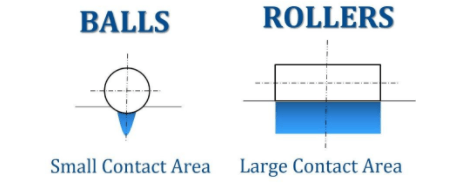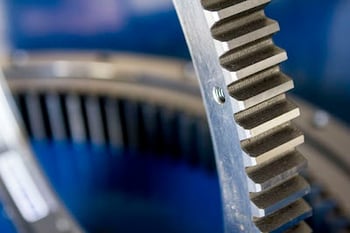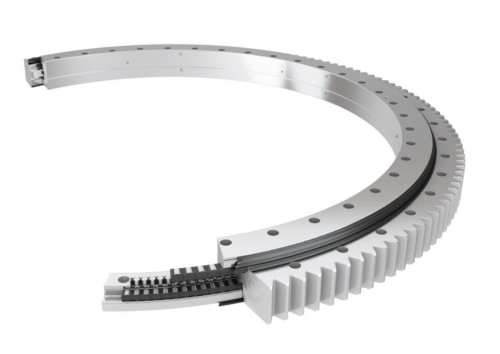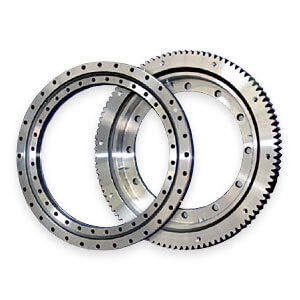Excavator slewing bearing is one of the important equipment in modern engineering construction. The excavator can rotate left and right during work, which is inseparable from the credit of the slewing mechanism. It is one of the important components of the hydraulic excavator. The slewing mechanism is connected with the walking device through a slewing support, and the slewing drive device makes the platform rotate relative to the walking device and drives it to rotate around its central axis of rotation. Today, the editor will tell you about the existence and working principle of excavator slewing bearings for everyone to learn and understand.
1. The existence of excavator slewing ring
1) rotary column excavator slewing bearing
In the structure of the slewing column type slewing bearing, the rotating body and the supporting shaft form a rotating column, which is inserted into the bearing of the bearing seat. The bearing seat is bolted to the frame. The shell of the swing cylinder is also fixed on the frame, and its output shaft is inserted into the lower bearing. The rotating body is driven to rotate relative to the frame. The working device is hinged on the revolving body and revolves with the revolving body, and the rotation angle is not more than 180°.
- Rolling bearing type slewing ring

Rolling bearings are compared with ordinary bearings. The speed is very slow, and the commonly used structure has two types: single-row ball and double-row ball. The single-row ball slewing bearing is mainly composed of inner ring, outer ring, isolator, rolling element and upper and lower sealing devices. The steel balls are separated by rolling elements, and the inner ring or outer ring is processed into an inner ring or an outer ring.
The inner gear ring is fixed on the walking frame, and the outer ring is firmly connected with the rotary platform. The slewing drive device is fixedly connected to the slewing platform and generally consists of a slewing hydraulic motor, a planetary reducer, and a slewing drive pinion. Through the meshing transmission of the driving pinion and the ring gear, The rotary device revolves around the inner ring gear while rotating. Thereby driving the platform to rotate 360°.
- Working principle of transmission

When the excavator slewing bearing is working, the position of the combined force of the upper part of the turntable and the load is constantly changing, and is biased towards the direction of the load. In order to balance the load moment, each device on the turntable needs to be reasonably arranged, and a counterweight is set at the tail to improve the force of the lower structure of the turntable, reduce the wear of the slewing bearing, and ensure the stability of the whole machine.
As the speed increases, the flow rate required by the swing motor also increases. When all the oil of the hydraulic pump is supplied to the swing motor, the start phase ends. The accumulator releases its energy at this moment, so the hydraulic pump and the oil from the accumulator are supplied to the slewing motor together, which speeds up the speed of the slewing motor. This is the second stage of starting.
The above is a brief introduction to the existence form and working principle of the excavator slewing bearing. Here is a reminder that after the excavator is used for a period of time, its slewing bearing is prone to noise, impact and other faults. The operator should pay attention to observe and check in time to eliminate malfunction. Only correct and reasonable maintenance and maintenance of the slewing ring can ensure its normal operation, give full play to its performance and extend its service life.
What is slewing in an excavator?
Slewing refers to rotating the excavator’s house assembly. Unlike a conventional backhoe, the operator can slew the entire house and workgroup upon the undercarriage for spoil placement.
Does slew mean a lot?
The definition of a slew is a large quantity of something. … A large amount or number; a lot. A slew of unpaid bills.
What is the difference between a slewing and non slewing crane?
In crane movement terms, a slewing crane lifts its load, suspends that load in mid-air, and then rotates it via a boom rotating mechanism. Non-slewing cranes, on the other hand, lack a rotating base section.
Is it Slough or Slew?
Slew is an informal word equivalent to many or lots (you have a slew of cattle). It is sometimes misspelled slough (a legitimate noun meaning “a grimy swamp” and pronounced to rhyme with now) or slue (a legitimate verb meaning “to swing around”).
How does an excavator swing brake work?
The discs and plates are lubricated by the release signal oil. When the engine is shut off, the swing brake is engaged by spring pressure on the brake pack. … This pressure signal enters the brake housing and releases the brake by forcing the piston to compress the brake spring.
What is a Rotex bearing?
Rotek slewing bearings are machine elements which absorb all axial and radial forces and the resulting tilting moments in a single self-retaining and ready-to-install unit.
What is a slew bearing on an excavator?
Excavator Slewing bearings comprise an inner ring and an outer ring, one of which usually incorporates a gear. Together with attachment holes in both rings, they enable an optimized power transmission with a simple and quick connection between adjacent machine components.
What slewing means?
transitive verb. 1 : to turn (something, such as a telescope or a ship’s spar) about a fixed point that is usually the axis. 2 : to cause to skid : veer slew a car around a turn. intransitive verb. 1 : to turn, twist, or swing about : pivot.
What is slew radius?
Radius. The horizontal distance from the reference line (e.g. centre of rotation of a slewing crane) to the load line (typically through the crane hook). Regular Load.
What is non-slewing?
A non-slewing mobile crane is a powered mobile crane that incorporates a boom or jib which does not slew and includes an articulated mobile crane or a locomotive crane but does not include vehicle tow trucks.
What does non-slewing mean?
A non-slewing mobile crane means a mobile crane, of greater than three tonnes capacity, incorporating a boom or jib that cannot be slewed. Includes: articulated type mobile cranes.
Is a Franna a slewing crane?
Successfully completing this course will allow you to operate any mobile cranes (up to 20t), any non-slewing crane (such as telehandlers or Franna cranes) and vehicle loading cranes (such as Hiab’s and Palfinger’s) and reach stackers within Australia.
LYMC excavator slewing bearing supplies the slewing rings to a wide range of the excavators, a good replacement slewing ring bearings used on Komatsu, Hitachi, Kobelco, Caterpillar, Hyundai and so on, we can supply according to the most of the machine number, and a lot of slewing rings are in stock for the quick delivery.
Below is the normal machine number we can supply the slewing ring bearings.The list of Crane and excavator.
For more types,please contact us freely.























 Slewing ring bearings, or turntable bearings, are ball or roller style bearings composed of two concentric rings either of which may include a gear. This type of bearing enhances load support and power transmission in all directions, and is typically employed to support heavy loads for slow applications and large equipment such as earth excavators and construction cranes. The unique power and versatility of slewing ring bearings has made them increasingly valuable in a wide array of industries, including construction, industrial, robotics, machine tooling, and medical applications.
Slewing ring bearings, or turntable bearings, are ball or roller style bearings composed of two concentric rings either of which may include a gear. This type of bearing enhances load support and power transmission in all directions, and is typically employed to support heavy loads for slow applications and large equipment such as earth excavators and construction cranes. The unique power and versatility of slewing ring bearings has made them increasingly valuable in a wide array of industries, including construction, industrial, robotics, machine tooling, and medical applications.


